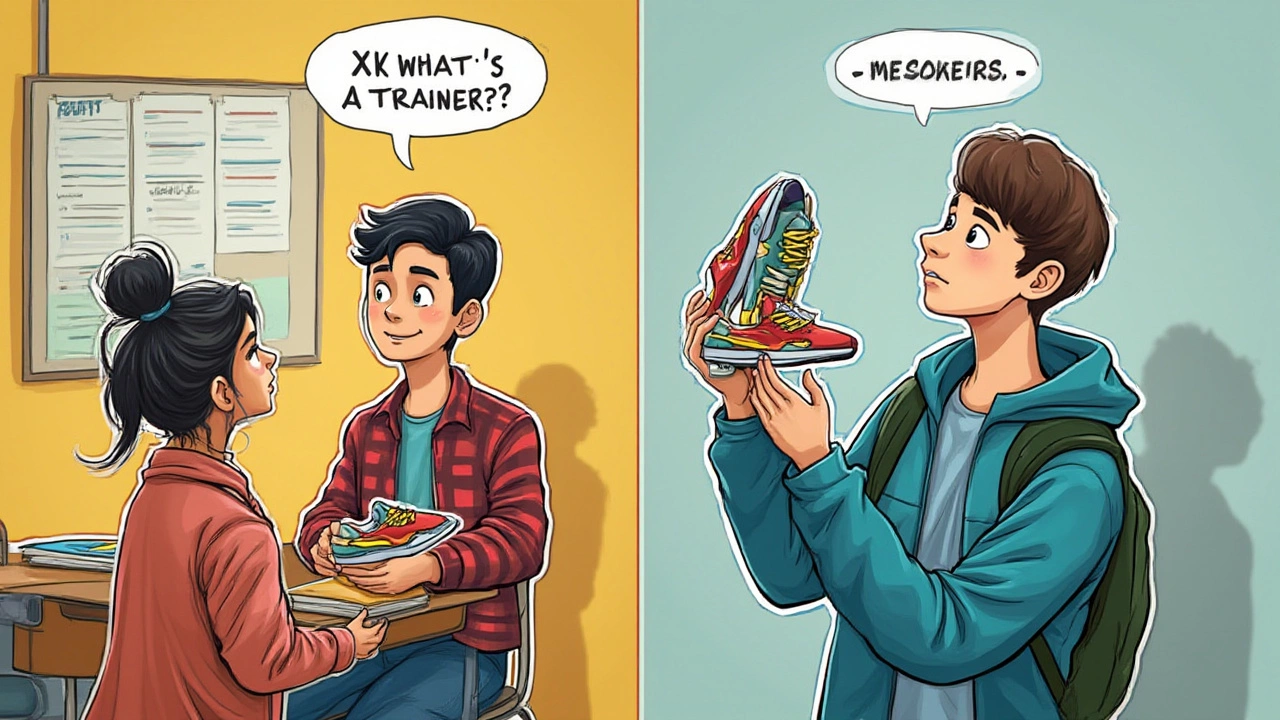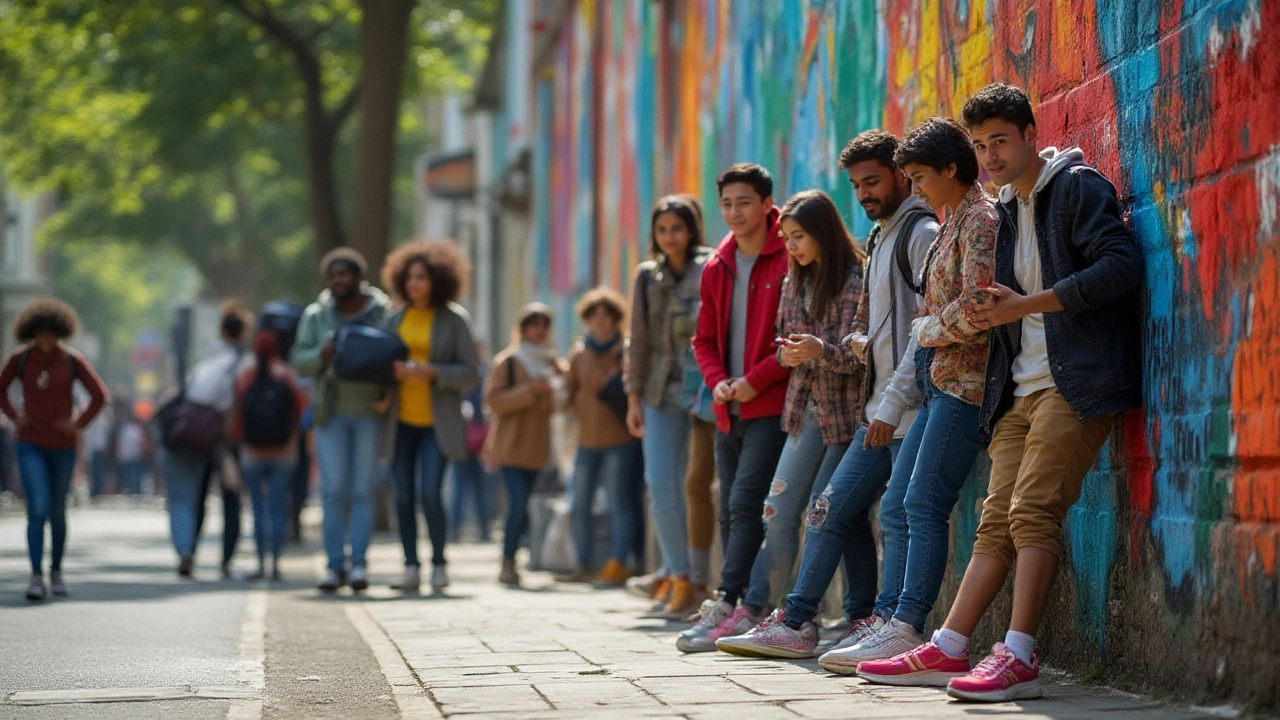If you ever walk into a London shoe store and ask for sneakers, you might get a confused look. But mention 'trainers' and you're instantly on the same page as everyone else. The way Brits talk about something as basic as shoes is packed with history and even a bit of national pride. It’s not just a word—it’s a marker of everyday culture, and if you get it right, you blend in that much quicker. Most Americans find this British habit pretty quirky, but there’s more going on than meets the eye. The word 'trainers' is a classic Britishism that says a lot about style, identity, and even the evolution of English around the world.
The Origins of 'Trainers' in British Slang
You might wonder, why 'trainers'? It traces back to the full title: training shoes. Back in the 1950s and 60s, Brits started using special rubber-soled shoes for sports and physical training at school. Instead of calling them 'sneakers' or 'tennis shoes,' people shortened 'training shoes' to 'trainers.' It caught on fast. Unlike in the States, where sports shoes get all sorts of names, in Britain, trainers became the go-to word for any casual, athletic-inspired shoe with a rubber sole—whether you’re lacing up for a jog or just grabbing coffee.
Fast-forward a few decades and the word 'trainers' hasn't budged. Ask anyone in Manchester, Glasgow, or Kent and they'll instantly picture those everyday shoes nearly everyone owns. This isn’t some posh phrase either. Everyone from kids in school to pensioners uses the word. And while some Brits know 'sneakers' thanks to American movies and TV, it just doesn't sound right to them. The cultural divide is real: Brits chuckle when they hear someone say 'sneakers,' and Americans often need a moment to translate when they hear 'trainers.'
Marketing made sure the term stuck. Sports brands like Adidas and Puma—both massively popular in the UK—advertised directly to British audiences as 'trainers,' not 'sneakers.' Even school uniform rules get in on the act, with strict lists that specify which trainers are allowed and which aren’t. So, the word works its way into everyday life, branding, and even official school policies. If you grew up in Britain any time since the 1970s, you probably had at least one pair of trainers that you argued with your parents over, usually about whether the bright stripes or air bubbles broke the dress code.
The British relationship with trainers has even influenced fashion designers and pop culture. Paul Smith and Vivienne Westwood—big names in British fashion—regularly work trainers into their catwalks, both for practical and aesthetic reasons. Trainers are woven into youth culture too, but not just for gym class. They pop up in British music scenes, from punk rockers in battered trainers to Britpop icons like Oasis, whose love of Adidas Sambas is the stuff of legend. Try counting the number of trainers in a crowded tube carriage on a Friday night, and you’ll see just how deep the love goes.
Even the Queen was rumored to have a pair of black leather trainers for country walks, showing just how universal the term is. So, next time you’re shoe shopping in the UK, remember: ask for trainers if you want to sound like a local. Otherwise, you might get directed to the nearest gym instead.
Trainers vs. Sneakers: What’s the Actual Difference?
Here’s where it gets interesting. If you look at the actual shoes, trainers and sneakers are almost identical. Both mean a comfy, rubber-soled shoe usually worn for sports or casual walking. So why the different words? It’s all about roots. Americans started using 'sneakers' in the early 20th century, because the rubber soles made the shoes so quiet you could 'sneak' around in them. Pretty clever, right? But British English stuck closer to function—if you’re training, you wear trainers.
Still, the word 'trainers' isn’t just used to talk about something sporty. Brits wear their trainers with jeans, dresses, or even suits if they’re pushing creative boundaries. You’ll see people in London stepping off the tube wearing trainers with tailored trousers or even formal workwear. No one bats an eye. British culture is pretty relaxed about mixing styles if trainers are involved—there are even luxury trainers made from Italian leather that cost more than a weekend in Paris, which is not an exaggeration. Brands like Alexander McQueen, Stella McCartney, and Burberry know exactly how popular trainers are and design to match.
Americans, on the other hand, can sometimes get hung up on when sneakers are appropriate. You’ll hear people debating if you can wear sneakers to work. That conversation is over in the UK—everyone does it already. The difference even crops up in everyday English. In British shows, a parent will shout to a kid, “Don’t forget your trainers for PE!” while in the US, it’s usually “Grab your sneakers for gym.” Same shoes, different mindset.
If you ever travel between the two countries and use the 'wrong' term, prepare for some teasing. I learned that the hard way visiting my wife Fiona’s family in Brighton—her cousin called me out for saying sneakers and everyone roared with laughter. By the end of the visit, I’d switched teams and only said trainers. Apparently, that means you’re halfway to being an honorary Brit.
Outside the UK, 'trainers' is also the word in Ireland, Australia, and New Zealand, while Canada and most of the US stick to 'sneakers.' If you meet someone from South Africa or India though, you might hear 'takkies'—a completely different word for the same thing. Language evolves, but these shoe words stick stubbornly to their roots.
Mix-ups do happen, though. Brits in New York sometimes get sent to the gym wear section instead of the shoe aisle. Tourists in London are amazed at how 'trainers' show up on every high street shop sign. The British Museum even ran an exhibit in 2018 dedicated to trainers and their cultural impact, with everything from 1980s Nike Air Jordans to classic Reeboks on display. That’s how deep the roots go in the UK.

The Place of Trainers in Modern British Fashion
Trainers aren’t just a casual option. They’ve walked straight into the center of British fashion. On the London streets, trainers are paired with everything—from ripped skinny jeans and wool coats to floral dresses and business suits. Fashion editors pick out trainers as a must-have almost every season, and you’ll always notice them in the front row of fashion shows. Even the usual suit-and-tie crowd in Canary Wharf happily change into trainers for the journey home, trading leather loafers for Nikes or Adidas, just for some comfort.
People aren’t just following trends; there’s real passion behind it. You’ll meet folks with entire wardrobes set aside for trainers—different styles for different moods, outfits, or even the weather. The British weather means that waterproof trainers, or at least a pair that can take a splash, are a real necessity. Serious sneakerheads (or ‘trainer heads’ as some call them) join online raffles or queue for hours to get exclusive releases. Drop days for limited edition trainers from brands like Yeezy or collaborations with British designers often sell out in minutes, both in-store and online. Queuing for trainers is almost an event of its own in places like Camden or Oxford Street.
Collecting trainers also gets competitive. Some pairs never get taken out of the box—think vintage Nike Air Max 1s or rare Asics. There are even Facebook groups and local sneaker-trading events dedicated solely to swapping or showing off prized pairs of trainers. A 2022 YouGov poll found that nearly 1 in 10 Britons owns more than five pairs of trainers. If that sounds extreme, wait till you meet the real collecting pros who have entire display cases at home.
And it’s not just about looking cool. Trainers have been embraced for their practicality and comfort, but they’ve also become a form of self-expression. Different styles send different signals—retro classics for a bit of nostalgia, chunky “dad” trainers for a bold, ironic statement, or all-white minimal pairs to look clean and fresh. The way people lace their trainers, the colors they pick, and even the state of wear all give away a bit about their personalities. Spot a pair of beat-up Converse in a pub and it’s a good bet their owner’s got good taste in music and a story or two from the 90s.
The message is clear: trainers aren’t just sports shoes anymore. They’re woven into the fabric of British street style, workwear, and even celebrations—don’t be surprised if you see someone getting married in box-fresh trainers. That blend of comfort, cool, and quirk is the best way to sum up how the British feel about their favourite footwear.
Tips for Spotting and Choosing Trainers in the UK
Ready to buy your first pair of British trainers, or just keen to blend in? Here’s what to look for. The UK has hundreds of trainer brands, from homegrown classics like Gola and Reebok to global heavyweights such as Nike, Adidas, Puma, and New Balance. British brands offer unique styles—Gola is famous for retro designs, while Reebok nails classic white trainers that go with anything. If you want to stand out, look for special collaborations, like Dr. Martens teaming up with various artists for limited-run trainers.
When shopping, pay attention to sizing. UK trainer sizes are usually a full size smaller than the US system, so double-check before you buy. Many shops let you try before you buy—just remember, British shops rarely use 'sneakers' in their signage. Most call their section ‘trainers’ or sometimes ‘sports footwear.’ If you ask for sneakers, expect a polite, bemused correction. And if you’re browsing online, most UK sites list the word 'trainers' right in search menus and categories. One tip—search for “best trainers 2025” or “UK trainer trends” for the latest releases or deals.
Take note of popular trainer styles. Right now, chunky ‘dad’ trainers are everywhere, but so are retro classics like Adidas Gazelles and Nike Air Force 1s. The British love versatile shoes, so pairs that work for both a muddy park walk and a casual pub dinner win big points. If you want to stay in style, avoid anything too flashy or covered in rhinestones—most Brits prefer understated, timeless designs with a twist. Still, anything goes on a festival field or at a football match, where bright colors and big logos show loyalty to a favorite brand or team.
To keep your trainers looking fresh, get a waterproof spray, especially with the UK’s famously rainy weather. Some folks even carry a tiny brush in their bag or backpack to wipe muddy spots off after a walk through the park. If you want your new trainers to last, avoid machine washing them—hand cleaning is the way to go. Swap out laces for a quick style update, or add cushioned insoles for serious comfort on all those city walks.
If you’re after something eco-friendly, look for trainers made from recycled or vegan materials. Brands like Veja and Stella McCartney are making waves in the UK with sustainable collections. These clips into wider British values—eco-conscious fashion is just as hot as limited edition drops.
And a final insider tip—never judge a British person’s whole style by their trainers alone. They might have mud on them from a weekend walk or paint splatters from a garden project, but those well-worn shoes usually have a story. Next time you’re chatting with a Brit, ask them where they got their trainers or why they love their current pair. You’ll get a mini life story in return—guaranteed. A single word, but it means so much more in the UK’s buzzing, sneaker-loving world.
